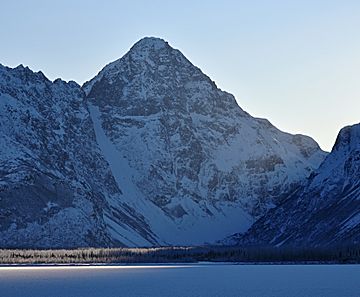The Mitre (Alaska) facts for kids
Quick facts for kids The Mitre |
|
|---|---|

North aspect of The Mitre from Eklutna Lake
|
|
| Highest point | |
| Elevation | 6,651 ft (2,027 m) |
| Prominence | 1,751 ft (534 m) |
| Isolation | 2.37 mi (3.81 km) |
| Parent peak | Benign Peak (7,235 ft) |
| Geography | |
| Location | Chugach State Park Anchorage Municipality, Alaska Alaska, United States |
| Parent range | Chugach Mountains |
| Topo map | USGS Anchorage B-6 |
The Mitre is a mountain peak that stands 6,651 ft (2,030 m) tall. It is located in the western Chugach Mountains in Anchorage Municipality, Alaska. This mountain is part of Chugach State Park. It is about 30 mi (48 km) east of the city of Anchorage.
The Mitre is also 3.5 mi (6 km) northeast of Peril Peak. It is 5.5 mi (9 km) south-southeast of Eklutna Lake. The closest taller mountain is Benign Peak, which is 2.4 mi (4 km) to the west-northwest. Benign Peak is on the other side of the Eklutna Glacier.
Even though The Mitre is not the tallest mountain, it rises very steeply. Its western side climbs 4,000 feet above the glacier in only about half a mile. In Europe, a "mitre" is a term for a sharp, pointed, and balanced rocky peak. The mountain's name, The Mitre, was suggested by Dr. Rodman Wilson. He was from Anchorage and a member of the Mountaineering Club of Alaska. He suggested the name after a trip to Europe. The name was officially accepted in 1966 by the United States Board on Geographic Names. In the Denaʼina language, this mountain is called Idlu Bena Dghelaya. This means Mountain of Plural Objects Lake.
What is the Climate Like at The Mitre?
The Mitre is in a subarctic climate zone. This means it has long, very cold, and snowy winters. The summers are usually mild. Weather systems from the Gulf of Alaska move towards the land. When they hit the Chugach Mountains, the air is forced to rise. This process is called orographic lift. It causes a lot of rain and snow to fall on the mountains.
Temperatures on The Mitre can drop below −20 °C. With the wind, it can feel even colder, sometimes below −30 °C. The water from the melting snow and rain flows down the mountain. This runoff eventually drains into Cook Inlet through the Eklutna River.


